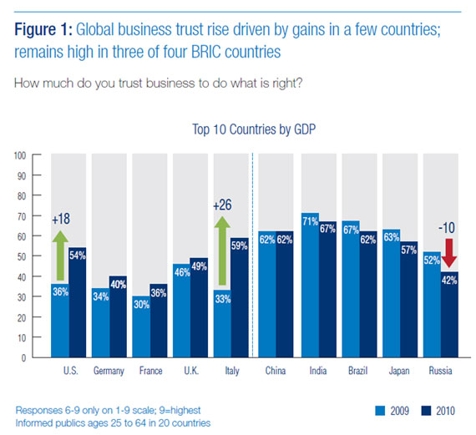Consumers buy from online retailers they trust, and unfortunately, nearly half of American consumers probably don’t trust your business.
Data from the Edelman Trust Barometer shows that in 2009 only 36 percent of Americans surveyed said that they thought U.S.-based companies were trustworthy. More recently that percentage has improved, and in early 2010, about 54 percent of Americans generally trusted businesses, but that still indicates that nearly half of consumers—your potential customers—don’t trust business in the U.S. to do what’s right.

Chart comparing the degree of trust in businesses, by country, for 2009 and 2010.
Marketing Confidence
As an online merchant there are several ways to address this apparent lack of trust with onsite marketing.
For example, adding trust seals from third party providers like VeriSign, TRUSTe, GeoTrust, McAfee Secure, and the Better Business Bureau can go a long way to alleviating consumer fears. And some anecdotal evidence shows that these seals can help to boost sales conversions.
It may also be a good idea to tout PCI compliance and even promote your efforts with a “Secure Shopping” page, describing the steps your business takes to protect customer credit card data and privacy.
While all of these techniques are effective, if not essential, onsite marketing tactics, they will not necessarily help your business overcome the confidence barrier offsite or help your business generate more site traffic.
Offsite Trust Marketing
Three new marketing trends are pushing trust marketing off-site. For clarity, you can think of trust marketing as the practice of communicating to potential customer that doing business with your company will result in a safe, mutually enriching experience that extends to every aspect of the relationship.
Trust Seals in Search Engine Results Pages
Recently VeriSign announced that its Trusted Seal was appearing on some search engine results pages (SERPs) thanks to a free malware detection tool called AVG Linkscanner.

Screenshot of Google search results showing trust marks.
The Trusted Seal appears in both organic results and paid advertising on Google, Bing, and Ask, and in organic results on Yahoo! when a user has the Linkscanner software installed and is searching using either Mozilla Firefox or Microsoft Internet Explorer.
AVG estimates that about 80 million users employ Linkscanner, so it may be safe to assume about those 80 million users are seeing the VeriSign Trusted seal when they search. While this is a small percentage of the total Internet audience it may still be significant.
Expect other trust seal providers to follow VeriSign’s lead and start showing up in SERPs.
Trust Seals in Comparison Shopping
Merchants can also market confidence on comparison shopping sites like The Find or PriceGrabber, which both display various trust seals and SSL certificates in search results.
Trust seals in these price-focused comparison tools are one of the last few ways to differentiate your store. And if your price matches your competitors and you have a trust seal, shoppers may choose you.

Screenshot of results on The Find showing trust marks.
Trust Marketing in Advertising and Email
Finally, you may want to consider including trust seals or links to a “Secure Shopping” landing page in your email, print, online, and PPC marketing.
For example, if you send out a regular newsletter, if may not be a bad idea to feature shopping security as an article or include trust seals in the email layout.
In pay-per-click ads, try adding a secure shopping statement and run an A/B test to see how the ad performs against similar ads.





